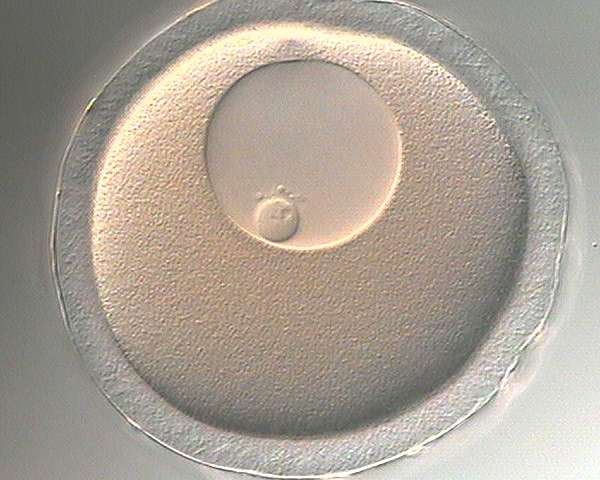August 26, 2015 report
Reprogramming the oocyte

(Phys.org)—Among other things, the egg is optimized to process the sperm genome. The cytoplasmic factors that make this possible also give the egg the ability to reprogram the nuclei from other kinds of cells if these nuclei are swapped into the egg. Although this 'somatic cell nuclear transfer' is a handy way to generate pluripotent cells (cells very similar to embryonic stem cells, or even clones like Dolly), there is significant logistical and ethical overhead to the procedure. The alternative is to take the 'transcription factor' or iPSC reprogramming approach which attempts to induce a pluripotent state from only partial knowledge of the full method used by the egg
The magic four set of transcription factors (Oct4, Sox2, Myc and Klf4), while just a subset of the class of maternal effect genes, are sufficient to make passable iPSCs. However, as a group of researchers from Singapore note in a recent Cell Reports paper, the main drawback is that they are less efficient at establishing complete, bona fide pluripotency. To try to improve this situation, the researchers screened 20 oocyte-enriched genes for their ability to further induce iPSC reprogramming of mouse fibroblasts which already expressed retroviral versions of the above factors.
The only factors that worked—ie. significantly increased the number of alkaline phosphatase positive iPSC colonies—were members of the T-cell leukemia (Tcl1) protein family. The researchers found that Tcl1's main partner in the cell is an RNA-binding protein called mitochondrial polynucleotide phosphorylase (PnPase). So now things can begin to get interesting. PnPase is a bifunctional enzyme with both exoribonuclease and oligonucleotide polymerase activity. In other words it can dismantle RNA chains and also long heteropolymeric tails.
In addition to their own RNA products, mitochondria are noted importers of various nuclear-encoded tRNAs as well the essential aminoacyl-tRNA synthetases. Mitochondrial RNA-binding proteins like PnPase are believed to be critical in the import and processing of RNAs in mitochondria. The author's finding that egg factors can reprogram metabolism by suppressing mitochondrial PnPase has far more general implications for stem cells.
For example, although somatic cells rely on oxidative phosphorylation, pluripotent cells preferentially use glycolysis as an energy source and typically have immature mitochondria. Recent work now indicates that the main role of electron transport in proliferating cells, both in development or in cancer, may simply be for the synthesis of aspartate. A new appreciation for the apportioning of mitochondria, again in development of the egg during the so-called germline bottleneck, later in germ cell specification, and in cancer unifies these concepts.
The suppression of mitochondrial biogenesis via the Tcl1-PnPase 'switch' is just one mechanism the researchers explored. They also found that a closely related homolog, Tcl1b1, could significantly boost the fibroblast somatic reprogramming. They note that PnPase is critical, at least in mice, not only for embryogenesis but for ear, muscle and brain development. They even suggest PnPase could be an important factor in new mitochondrial replacement therapies.
More information: Oocyte Factors Suppress Mitochondrial Polynucleotide Phosphorylase to Remodel the Metabolome and Enhance Reprogramming, Cell Reports, Volume 12, Issue 7, p1080–1088, 18 August 2015. dx.doi.org/10.1016/j.celrep.2015.07.032
Abstract
Oocyte factors not only drive somatic cell nuclear transfer reprogramming but also augment the efficiency and quality of induced pluripotent stem cell (iPSC) reprogramming. Here, we show that the oocyte-enriched factors Tcl1 and Tcl1b1 significantly enhance reprogramming efficiency. Clonal analysis of pluripotency biomarkers further show that the Tcl1 oocyte factors improve the quality of reprogramming. Mechanistically, we find that the enhancement effect of Tcl1b1 depends on Akt, one of its putative targets. In contrast, Tcl1 suppresses the mitochondrial polynucleotide phosphorylase (PnPase) to promote reprogramming. Knockdown of PnPase rescues the inhibitory effect from Tcl1 knockdown during reprogramming, whereas PnPase overexpression abrogates the enhancement from Tcl1 overexpression. We further demonstrate that Tcl1 suppresses PnPase's mitochondrial localization to inhibit mitochondrial biogenesis and oxidation phosphorylation, thus remodeling the metabolome. Hence, we identified the Tcl1-PnPase pathway as a critical mitochondrial switch during reprogramming.
Journal information: Cell Reports
© 2015 Phys.org


















